Day 3: 19 April 2023
By Gayathri R
(My comments in italics)
Vijay had warned that it was a long hot day, and we were all to be prepared.
The sanctuary is a dry deciduous forest and the flora includes thorny hardwood and xerophytes: Dalbergia horrida, Dichrostachys cinerea, Vachellia horrida, Acacia planifrons, Albizia amara, Zizyphus. The place also hosts spotted deer, jungle cat, mongoose, black naped hare, scaly anteater(pangolin), vipers and rat snakes and nearly 100 other species of birds are found in the area/
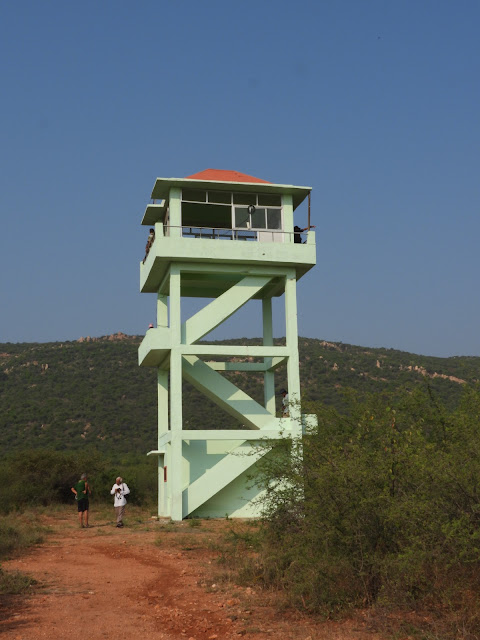 | |||||
| We reached and climbed down from our bus into the searing dry heat, and up to the tower. |
Thanikai explained the importance of the scrub and how this 16sqkms is like the last and southernmost refuge for the Blackbuck, with a hillock on one side and the highway on the other. It is important for such scrub habitats to be preserved, but I did wonder about this isolated sanctuary and what it meant for the population of Blackbuck, cutoff from other populations and inbreeding.
 |
| From up there, as we scanned the sanctuary, I saw a beautiful Paradise Flycatcher, a brown shrike, a skulking coucal and a Collared Dove, besides the 6 0r 7 Blackbuck fawns. We did not spot a male. |
 |
| Photo by Sagarika - The Blackbuck fawns |
 |
| The brown shrike - lovely capture by Sheila. Observe the thorns of the Acacia! |
 |
 |
| Photo by Sagarika - We saw this Agamid. I gave it a casual once over and walked on.... |
Many more of the interesting flora and fauna are on iNaturalist, here.
All were picked up from different parts of the track, and a slightly cranky and hot group got into the bus and headed to the Range Office, where our breakfast awaited. A few puris later, everyone's spirits were up again! Hats off to the remarkable team at Atree who kept us fed and hydrated - the age range of our group was from some 10 years to around 70 I guess, and between Vijay's remarkable people management and Thanikai and group, all diverse needs were taken care off! The drinking water arrangement was interesting - I had never seen this handy little battery operated "pump" that fitted on top of the 20 litre water can, enabling us all to keep refilling our water bottles. The Range Office also had a set of toilets, and soon we were all set to depart.
There was a Pied Crested Cuckoo at the rear of the campus, which I did not see as I was busy with the puris. Some others were smarter- they managed the puris and the cuckoo.
Therikaadu - the red desert.
What an amazing landscape! I had read about it before our trip, but nothing quite prepares you for the sight - red sand, dunes and searing heat in the middle of peninsular India!
 |
| Situated close to tiruchendur, and just 15-20 kms from the coast, Therikaadu appears like this huge red Martian area in the middle of TN. |
 |
| We climbed up dunes like this. |
 |
| We gathered up around Thanikai, under the shade of a cashew to understand the geology of this place. |
Hrishu was given the taske of telling us what he knew. Here's how I understood it - the land breezes blowing down the Nilgiris erode the laterite rocks carrying fine sand. These winds collide with the sea breezes blowing in the opposite direction, and this has caused the red sands to get deposited here over centuries.
The "Aeolian Process" is detailed here.
Now these were just plain sand dunes with nothing growing on them. But these are shifting sand dunes, which does not suit humans who want to deal with certainty and stability. So, we have tried to "control" the shifting it appears. How to prevent the dunes from shifting onto agricultural land? Wind Breaks and Shelter Belts are being tried, it seems. The cashews, casuarina and Palmyra are all planted more recently - even Neem has been tried, along with Kodakupuli.
 |
| It was too hot to linger on the dunes and we all moved from bush to bush seeking shelter. i could almost feel the sun dehdrating me, drawing the waters from my body, sucking me dry!! |
 |
| I tasted cashew fruit for the first time - it was too astringent for my liking, though full of water. |
We were all grateful to sink into the bus seats, and turn on the airconditioning as we headed to our next stop.
We made our way to the Arunjunai Katha Ayyanar Thirukkovil which comprises of sacred groves, century old trees, ponds with lots of water birds.
 The sands were red here also - it is the periphery of the Therikaadu. Thanikai explained how this was a land of "eris" - lakes and ponds, some as large as an ocean, with some 30 villages around the periphery. There is no connection between these rainwater tanks and the Thamirabarani river.
The sands were red here also - it is the periphery of the Therikaadu. Thanikai explained how this was a land of "eris" - lakes and ponds, some as large as an ocean, with some 30 villages around the periphery. There is no connection between these rainwater tanks and the Thamirabarani river.
The tanks hosted temples and the trees around became sacred groves, protected by the people.
Thanikai explained that the palm trees, Screw pines (kewras) and Barringtonia groves were all very old and made for an interesting array of landscapes. A 400 year old Naval (Jamun) was also around. And the ponds and tanks were filled with birds.
 |
| We saw this large peepul surrounded and protected by stone deities including this Ayyanaar which was quite magnificent. |
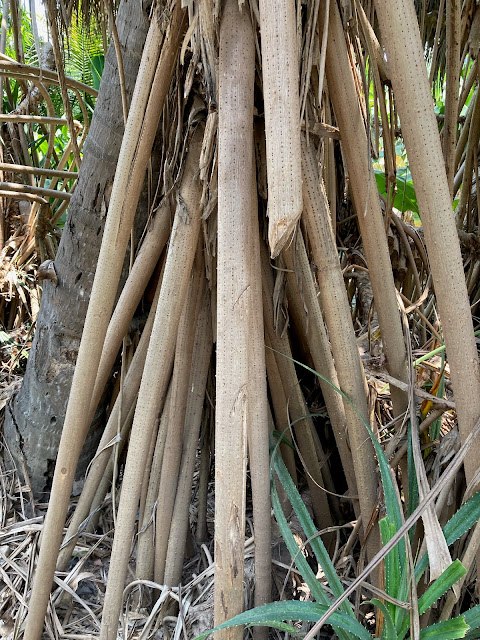 |
| The Barringtonia roots were stunning, and stood tall along with kewras - roots seen in the picture, indicating the presence of water, even if they were dry in April. |
It was very warm and humid, but under the tall trees we were fine. The road was filled with tamarind trees as well. Lyra and Neil had discovered an interesting shoe stamping game - interesting for them I mean. They were keeping score, much to my amusement.
At one point, we rounded the corner, and suddenly there were no tall trees, just a long road with large tanks on either side, filled with water birds, standing listlessly in the ponds. For some reason, at this point my body battery ran out, and I just felt extremely tired and drained. I dragged myself from tree cover to tree cover, for a bit. We saw both the jacanas, grey herons in plenty as also Brahminy Kites.
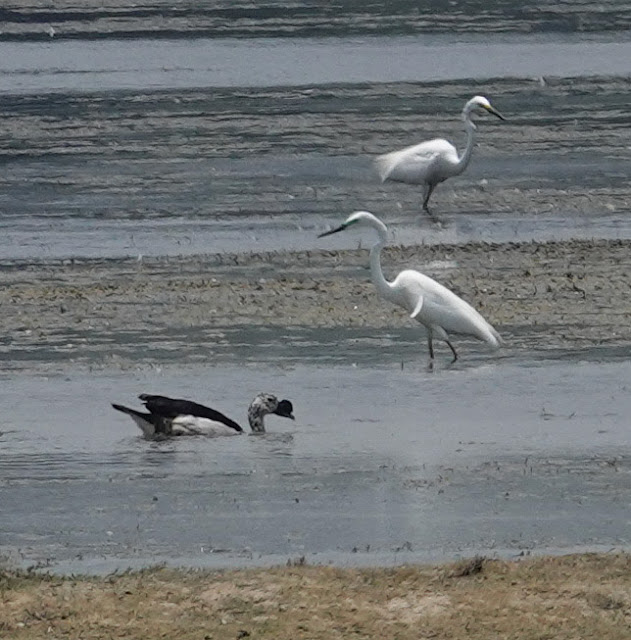 |
| But the biggest excitement was for the Comb Ducks - recognisable with their larger size, but far away in the distance. (Sagarika's Photo) |
 |
| Lunchtime, came the welcome announcement, and we skulked by the short cut back to the Arunjunai Katha Ayyanar Thirukkovil, where we started. See the way the temple envelops the Arjuna tree within it. |
 |
| Mr Shankarnarayan's Picture of the beautiful Ayyanar from the Arunjunai Katha Ayyanar temple |
Punnakayal
At around 3 PM we reached Punnakayal, a small fishing town. This is the place where the river Thamirabarani meets the sea.
 |
| Boats were coming in with all sort of catch. |
 |
| We witnessed a quick and efficient auction of this load of octpuses, |
 |
| as also these mussels, which were being exported to China. I wondered about the sustainability of this all, but of course I have no idea, and I am hoping the local fisherfolk know better. |
 |
| Conspicuously absent at this time of day were the women - I did not see a single one. |
We were shown the day’s catch along with starfishes, rays, crabs, octopuses and jellyfish.
 |
| We sighted Brown-headed Gull, Black-headed Gull
and many Brahminy Kites. (This brown headed Gull photo by Baskaran) |
We were taken to a small island patch where we walked around and found beautiful shells of sea-urchins, colorful shells and flora unique to the ecosystem. We tasted a small leaved plant which the fisher-folks said would be a bit salty.
One other interesting behaviour we observed was of a Brahminy Kite. It was hovering above us eating the fish it held in its claws.
We could see it in close quarters and clicked some good pictures. Other birds spotted on this day was White-eyed Buzzard, Ashy-crowned Sparrow Lark, Great Thickknee, Whimbrel, Western Marsh Harrier and Western Reef Egret.
 |
| We returned around 6pm, and witnessed a beautiful sunset as well. |
The journey back was long and we reached our stay at 9 PM. We had dinner and some of us (not me!) went for a night walk with Mr. Thanikaivel, escorted by Gingee, the pet dog there. We saw 3 vine snakes, scorpions with it’s young ones, a small white-breasted waterhen sitting on a tree and a Indian Black Turtle along the waterbody.




































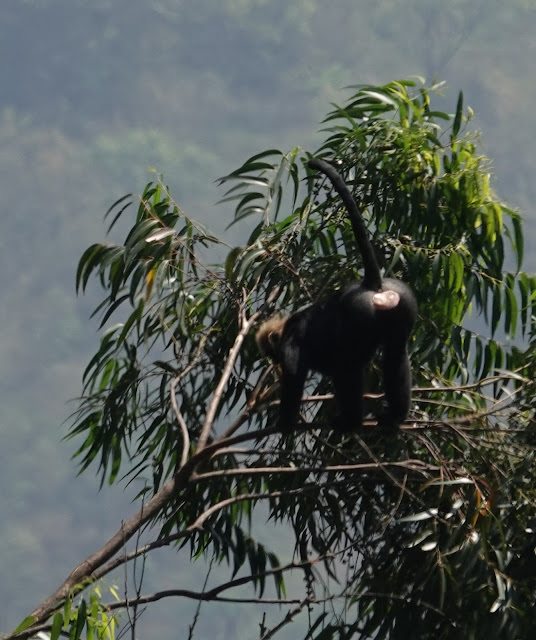








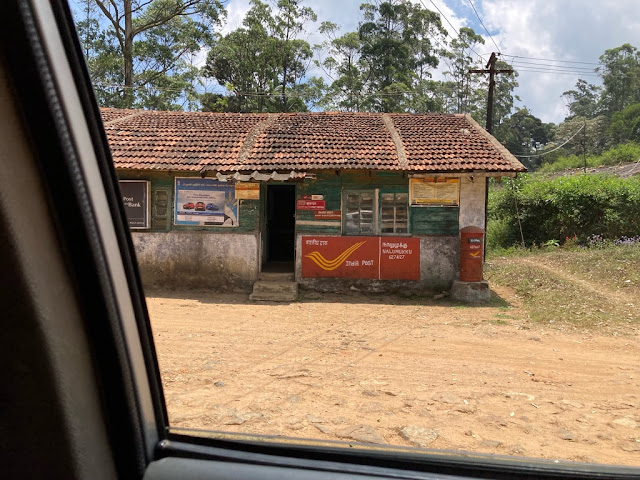


















%2Bcopy.jpg)